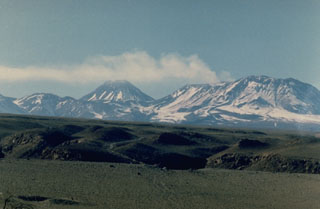Report on Lascar (Chile) — March 1992
Bulletin of the Global Volcanism Network, vol. 17, no. 3 (March 1992)
Managing Editor: Lindsay McClelland.
Lascar (Chile) New lava dome in central crater; fumarolic activity
Please cite this report as:
Global Volcanism Program, 1992. Report on Lascar (Chile) (McClelland, L., ed.). Bulletin of the Global Volcanism Network, 17:3. Smithsonian Institution. https://doi.org/10.5479/si.GVP.BGVN199203-355100
Lascar
Chile
23.37°S, 67.73°W; summit elev. 5592 m
All times are local (unless otherwise noted)
Growth of a new dome and fumarolic activity were observed in the active central crater (800 m wide, 350 m deep) during 26 Feb-8 March observations. The new dome, at the base of the crater's S wall, had a fresh surface of black spines and an apparent diameter of <1/3 the size of the dome erupted in 1989 (~200 m). Estimation of its size and shape was difficult because of its position directly below the observation point. The dome was apparently in an early stage of extrusion, and local authorities were warned of the possibility of large explosions within the next few months, similar to those in September 1986 and February 1990.
Fumarolic activity and sulfur deposition occurred along ring fractures elsewhere in the crater, and a strong sulfur odor was noted on the volcano's N and S flanks. White steam emissions to 300-500 m above the rim were punctuated by sporadic vigorous pulses of alternating white and dark gray columns, which rose to 2,500 m. Gentle summer winds primarily carried the plumes SE, although plumes extending northward were commonly observed in the morning. Although activity was vigorous, the jet fumaroles seen in the crater during a previous dome-building episode in 1989 (14:11) were not evident in 1992. No night glow was observed nor was seismicity recorded during the February-March observation period. Although there is no current seismic monitoring in the area, visual observations continue from nearby villages.
Geological Summary. Láscar is the most active volcano of the northern Chilean Andes. The andesitic-to-dacitic stratovolcano contains six overlapping summit craters. Prominent lava flows descend its NW flanks. An older, higher stratovolcano 5 km E, Volcán Aguas Calientes, displays a well-developed summit crater and a probable Holocene lava flow near its summit (de Silva and Francis, 1991). Láscar consists of two major edifices; activity began at the eastern volcano and then shifted to the western cone. The largest eruption took place about 26,500 years ago, and following the eruption of the Tumbres scoria flow about 9000 years ago, activity shifted back to the eastern edifice, where three overlapping craters were formed. Frequent small-to-moderate explosive eruptions have been recorded since the mid-19th century, along with periodic larger eruptions that produced ashfall hundreds of kilometers away. The largest historical eruption took place in 1993, producing pyroclastic flows to 8.5 km NW of the summit and ashfall in Buenos Aires.
Information Contacts: M. Gardeweg, SERNAGEOMIN, Santiago; S. Sparks and R. Thomas, Univ of Bristol; M. Murphy, Univ College, Dublin.

